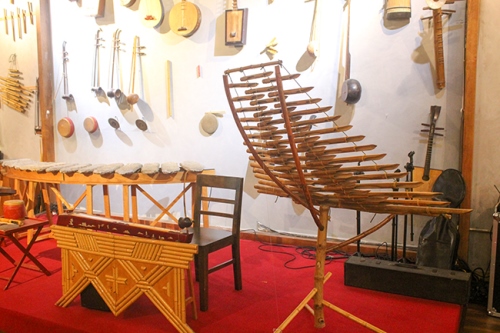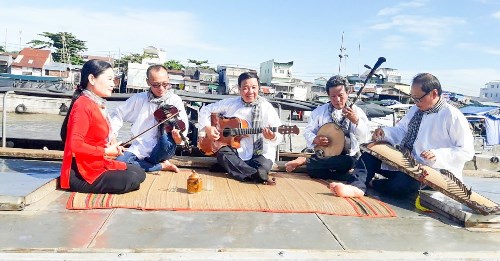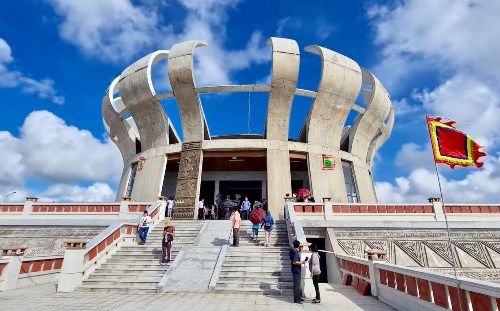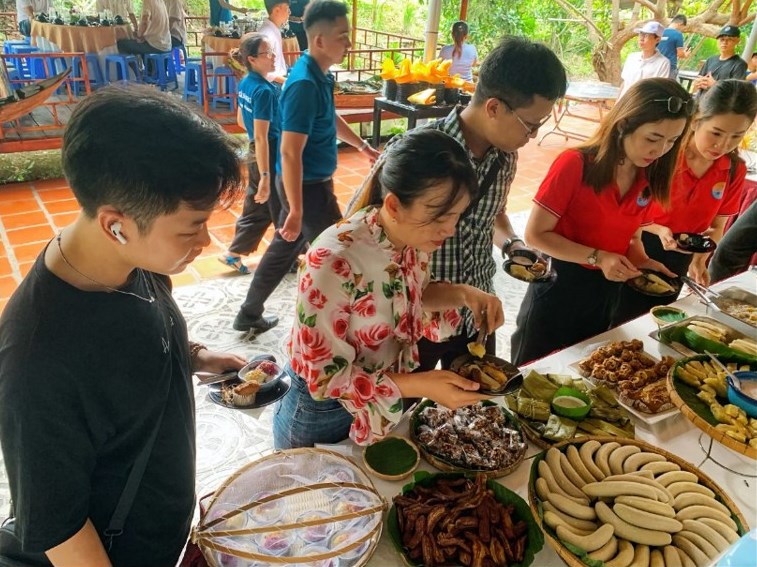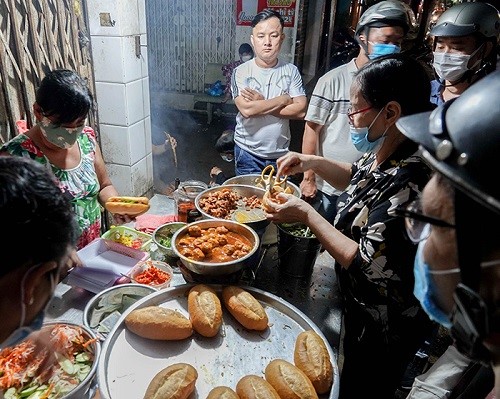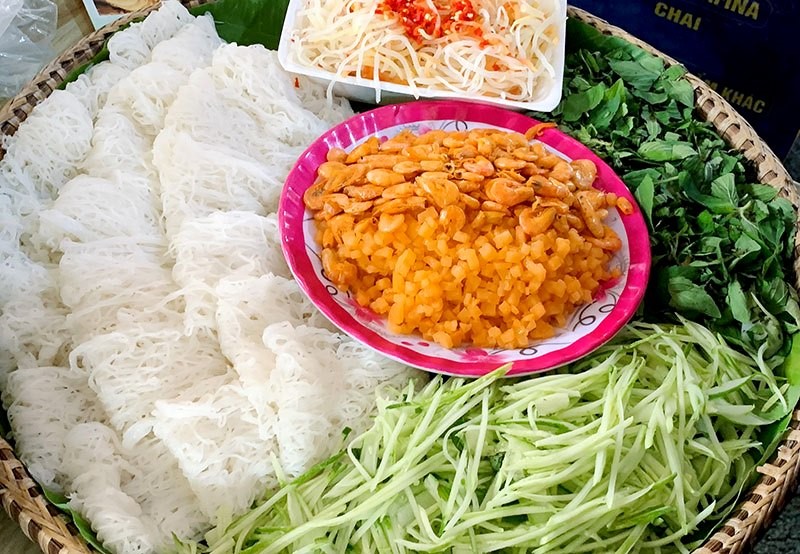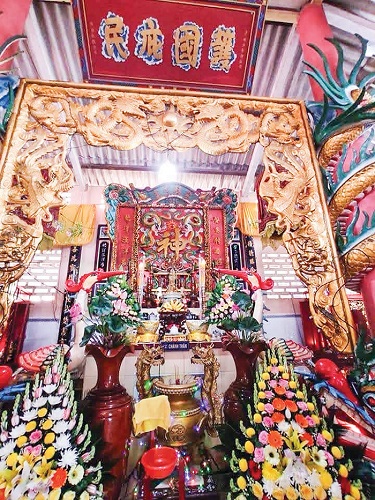
Some information about the historical figure and the region.
Mr. Chau Van Tiep (1738-1784), whose clan name is Chau Doan Nganh, originated from Binh Dinh province but resided in Van Hoa Village, Dong Xuan District, Phu Yen Province (Van Hoa Village is now Van Hoa Commune, Son Hoa District). He was one of the Gia Dinh Tam Hung (three tigers of Gia Dinh), including Do Thanh Nhon (?-1781), Chau Van Tiep, and Vo Tanh (?-1801). Gia Dinh Tam Hung, also known as the "Three Tigers" of Ben Nghe's soldiers (according to Nguyen Dong Trieu - Phan Manh Hung, "Searching in the Han Nom Heritage at Chau Van Tiep Temple," Xua & Nay Magazine, Issue 452, October 2014).
According to the Thoi Thuan hamlet records and Thanh Hoa Trung hamlet records in 1836, Tan Loc Islet today consists of two main islets: Thoi Thanh Islet and Cat Islet. Thoi Thanh Islet stretches from Dau Mom (local name) to approximately the same level as the Ca Ho Canal. Within this area, from Dau Mom to approximately the same level as Tra Uoi canal, it belongs to Thoi Thuan hamlet, and from approximately the same level as Tra Uoi canal to the same level as Ca Ho canal, it belongs to Thanh Hoa Trung hamlet. Cat Islet belongs to Tan Loc Dong hamlet, which is one of the 37 hamlets and villages in Vinh Dinh district (not yet divided), Dinh Vien prefecture, Vinh Thanh town. In the reign of King Minh Mang, Tan Loc Dong hamlet belonged to Dinh Thoi, Vinh Dinh district, Tan Thanh prefecture, An Giang province. In 1897, the French colonial authorities officially established Tan Loc Tay village and Tan Loc Dong village under Dinh My, Thot Not district, Long Xuyen province.
In 1920, Tan Loc Tay village (under Dinh My, Thot Not district, Long Xuyen province) merged with two parts of land originally belonging to Thoi Thuan hamlet and Thanh Hoa Trung Nhut hamlet, which were located on Thoi Thanh Islet. At the beginning of the French colonial period, Thanh Hoa Trung hamlet was divided into two hamlets: Thanh Hoa Trung Nhut and Thanh Hoa Trung Nhi. At this time, the land on Thoi Thanh Islet belonged to Thanh Hoa Trung Nhat hamlet. In the book "Research on the An Giang Province's Nguyen Dynasty Administrative Divisions" by Nguyen Dinh Dau, as of December 1970, it was already called Tan Loc Tay commune but still belonged to Thot Not district, An Giang province, with an area of 18.9 km2 and a population of 10,735 people. After April 30, 1975, Tan Loc Dong and Tan Loc Tay communes merged to form Tan Loc commune, which is now Tan Loc Ward, Thot Not District, Can Tho City.
The history of the formation of Tan Loc Tay Temple.
As mentioned earlier, Cat Islet (now Tan Loc Islet) during the Nguyen Dynasty had two hamlets: Tan Loc Dong and Tan Loc Tay. Although there were two hamlets, there was only one temple, which is the Tan Loc Dong Temple, bestowed the title of Bon Canh Thanh Hoang by King Tu Duc on November 29, 1852. Realizing the need for a temple for the people of Tan Loc Tay hamlet, in 1925, Mr. Nguyen Van Ngoc - head of village, along with the village officials, mobilized the people's efforts to establish Tan Loc Tay Temple.
Tan Loc Tay Temple is located next to the left bank of the Hau River, in the Ca Ho canal. At that time, the village's communal house was located in Ca Bao hamlet (now the Truong Tho 1 area). In 1927, due to severe erosion in the area, which threatened the temple, Mr. Ton, a local teacher, donated 1 piece of land (about 1 hectare) to the temple for long-term worship. Mr. Do Van Cang, along with other village officials, mobilized the community to relocate the temple to the new site.

The royal decree of King Bao Dai conferred the title "Trac Vi Duc Bao Trung Hung Thuong Dang Ton Than" on Mr. Chau Van Tien. Photo: TS Doan Hong Nguyen.
Afterwards, the temple's committee requested an official royal decree. The task of requesting the decree was assigned by Mr. Do Tai Nguyen to Mr. Tran Mao (also known as Tran Nao). Mr. Tran Mao, whose origins are unknown, came to the village seeking refuge. Seeing his talent and fluency in French, Mr. Do Tai Nguyen appointed him as the Secretary and later promoted him to the position of village manager. After the Japanese coup, when the French army was defeated and withdrew from Vietnam, it was revealed that he had been involved in revolutionary activities. On March 22, 1944, in the 19th year of Bao Dai's reign, the royal court in Hue conferred the following decree: Roughly translated, the decree conferred the title of the guardian deity of Tan Loc Tay Village, An My Commune, Thoc Noc District, Long Xuyên Province, upon Mr. Chau Van Tien, who had devotedly served the country and its people for a long time. Recognizing his great contributions, the deity was honored with the title "Trac Vi Duc Bao Trung Hung Thuong Dang Ton Than". The decree emphasized the meticulousness of worship. May the deity assist and protect our people. Kham tai! On March 22, 1944, 19th year of Bao Dai's reign.
After receiving the royal decree, the temple held a ceremony, and the decree was kept at Village Head Mr. Nguyen Van Chien's house. In the year of Dinh Suu (1997), Mr. Nguyen Van Chien passed away, and the decree was moved to Mr. Huynh Cong Phen's house. In the year of Canh Thin 2000, Mr. Huynh Cong Phen also passed away, and Mr. Huynh Van Giao (who held the position of Boi bai) brought the decree back to his house for continued worship. In 2011, the temple committee gathered opinions and decided to permanently place the decree at the temple.
In 1990, Mr. Do Huu Tong, the head of the temple committee, along with his brother Do Huu Thoi and the temple committee, called on the community to contribute to the renovation and reconstruction of the temple. The basic construction of the temple was completed, but the fence and the Xa Tac shrine were not yet finished. Therefore, Mr. Do Huu Thoi, as the current head of the temple committee, along with people in the area, continued the construction from January 16th, 2007, to February 26th, 2007, until it was completed. The temple occupies an area of 7,230 square meters, with a building area of 2,800 square meters.
Architecture and rituals:
The Tan Loc Tay Temple has a one-character architecture (-). In which, the East (front) side is adjacent to Tan Tay market, the South (right) side is adjacent to Dinh canal, the West (back) side is adjacent to Tan Loc - Lai Vung ferry terminal, and the North (left) side is adjacent to the Hau River.
From Tan Tay market, you enter through the Nghi gate/Tam quan, a large gate with a double dragon fighting over a pearl and three deities of Fortune - Prosperity - Longevity on the roof. Below is a large horizontal board that says "Chau Van Tien Temple" along with a couplet in front: "New progress meets good fortune, so the whole village prospers / Wealth returns, bringing good fortune to the entire community." The couplet behind reads: "Fortune brings prosperity to the village, creating a harmonious atmosphere / Luck shines, glorifying the homeland."
Passing through the gate, there is the Xa Tac shrine with a large statue of the Four Spiritual Animals and the double dragon fighting over a pearl wrapped around the spiritual tablet. On the left side of the shrine is the Bach Ho Temple with a nearly 1-ton white tiger statue. On the right side of the shrine is the Ngu Hanh Temple, worshiping the five symbolic statues of Metal, Wood, Water, Fire, and Earth. Directly in front of the shrine is a bas-relief depicting the Five Emperors of the Prehistoric Era, while on the left, opposite the Bach Ho Temple, there are depictions of historical events.
Stepping into the temple's roofed area, there is a stage surrounded by fences, with two flags of swords and spears with ceremonial weapons in the martial arts area. Next is the main worship hall, with a four-character Thai Binh Ngoc Chuc plaque above the entrance, and three ancient-style tiled roofs, along with eight statues of Eight Immortals and a pair of double dragons fighting over a pearl. There are also paintings depicting the scene of General Ly Thuong Kiet's battle against the Song Dynasty. Inside the main worship hall is the Council of One Hundred Officials, with a picture of 30 modern national heroes. Behind the Council is the altar of Lord Chau with the inscription "Hien hach anh linh", and on both sides are couplets praising the merits of the Deity: "The fame of the divine spirit shines brightly, passed down from ancient times to the present / The grace of the Deity is deep and wide, spreading everywhere." In the middle is the word "Deity" surrounded by the Four Spirits. Outside, there are a pair of cranes standing on a tortoise, along with a pair of dragons paying homage, and above them is a horizontal board with the inscription "Defending the country, benefiting the people". Additionally, there are decorative ceremonial weapons. On both sides, there are altars for various deities and the spiritual tablets of the past Village officials.
Behind the main worship hall is the communal house. On the right side of the main worship hall is the Tien Su Temple, which is used to receive esteemed guests when visiting the temple.
Every year, the Ha Dien Festival at Tan Loc Tay Temple takes place on the 19th, 20th, and 21st of the 3rd lunar month, while the Thuong Dien Festival takes place on the 20th and 21st of the 11th lunar month. In addition to these two major festivals, the temple also holds ceremonies for the Tam Nguon (15th of the 1st, 7th, and 10th lunar months), the 5th day of the 5th lunar month, the erecting of the Neu pole (30th of the 12th lunar month), and the mountain-opening ceremony (7th day of the 1st lunar month).
-------------------
REFERENCES.
1. "Dii Nam nhat thong chi" (The Comprehensive Chronicle of Unified Đại Nam), Volume 30, An Giang Province, page 169.
2. The primary source of information is based on the accounts of Mr. Đo Huu Thoi (recorded by elders of the past) and some relevant living elders.
3. Nguyen Dinh Dau (1995), "Research on the Administrative Divisions of Nguyen Dynasty in An Giang (An Giang, Dong Thap, Can Tho, Soc Trang)", Ho Chi Minh City Publishing House.
4. Cao Van Nghiep, "Some observations on 'Tan Loc Islet' according to the annotations by Pham Hoang Quan", posted on personal Facebook page "Ca Vang" (Golden Fish).
5. Nguyen Dong Trieu - Phan Manh Hung, "Exploring Han Nom Heritage Documents at Chau Van Tiep Temple", Xua & Nay Magazine, Issue 452, October 2014.
Source: Can Tho Newspaper - Translated by Chi Nguyen





